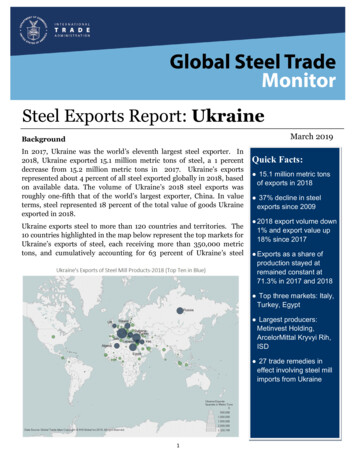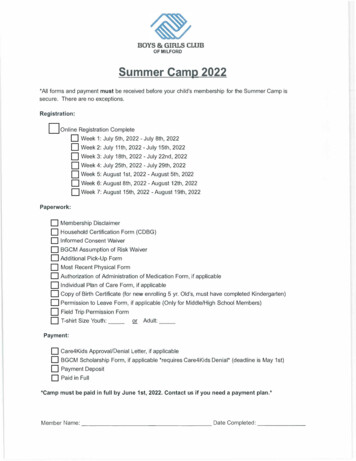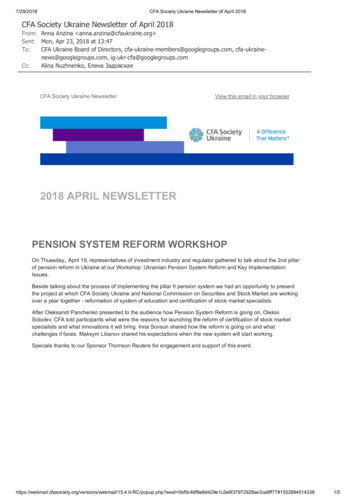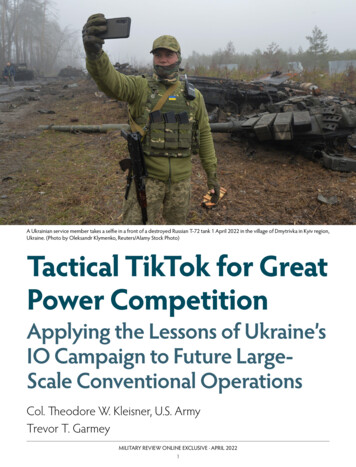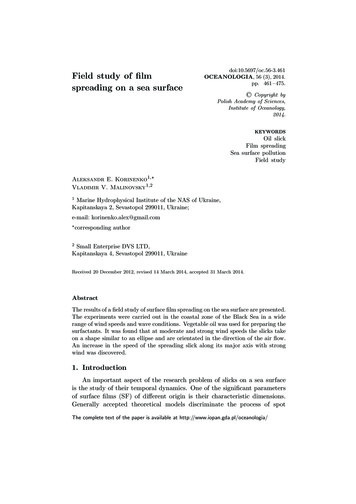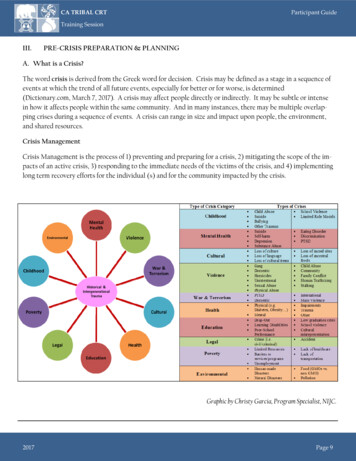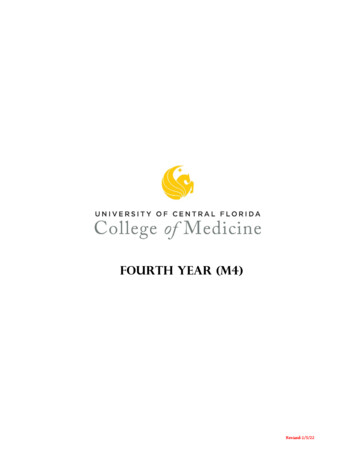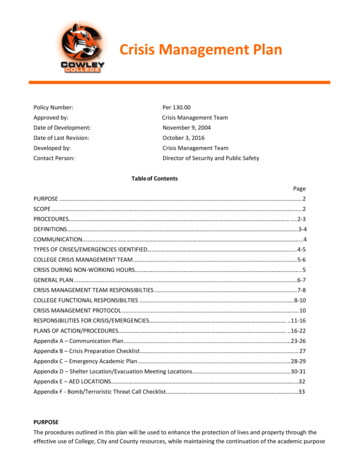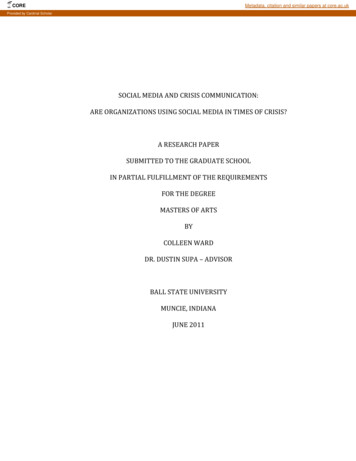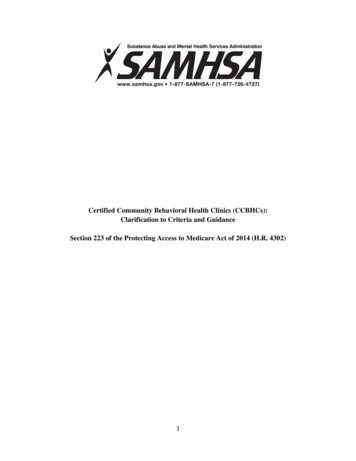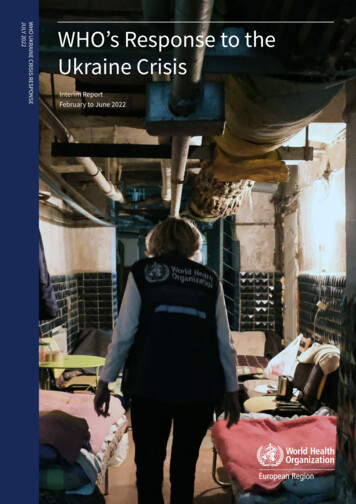
Transcription
WHO UKRAINE CRISIS RESPONSEJULY 2022WHO’s Response to theUkraine CrisisInterim ReportFebruary to June 2022
Document number: WHO/EURO:2022-5897-456620-65580 World Health Organization 2022Some rights reserved. This work is available under the Creative Commons AttributionNonCommercial-ShareAlike 3.0 IGO licence (CC BY-NC-SA 3.0 IGO; igo).Under the terms of this licence, you may copy, redistribute and adapt the work for noncommercial purposes, provided the work is appropriately cited, as indicated below. In anyuse of this work, there should be no suggestion that WHO endorses any specific organization,products or services. The use of the WHO logo is not permitted. If you adapt the work, then youmust license your work under the same or equivalent Creative Commons licence. If you createa translation of this work, you should add the following disclaimer along with the suggestedcitation: “This translation was not created by the World Health Organization (WHO). WHO is notresponsible for the content or accuracy of this translation. The original English edition shallbe the binding and authentic edition: WHO’s Response to the Ukraine Crisis: interim report,February to June 2022. Copenhagen: WHO Regional Office for Europe; 2022”.Any mediation relating to disputes arising under the licence shall be conducted in accordancewith the mediation rules of the World Intellectual Property Organization ested citation. WHO’s Response to the Ukraine Crisis: interim report, February to June2022. Copenhagen: WHO Regional Office for Europe; 2022. Licence: CC BY-NC-SA 3.0 IGO.Cataloguing-in-Publication (CIP) data. CIP data are available at http://apps.who.int/iris.Sales, rights and licensing. To purchase WHO publications, see http://apps.who.int/bookorders.To submit requests for commercial use and queries on rights and licensing, see http://www.who.int/about/licensing.Third-party materials. If you wish to reuse material from this work that is attributed to a thirdparty, such as tables, figures or images, it is your responsibility to determine whether permissionis needed for that reuse and to obtain permission from the copyright holder. The risk of claimsresulting from infringement of any third-party-owned component in the work rests solely withthe user.General disclaimers. The designations employed and the presentation of the material inthis publication do not imply the expression of any opinion whatsoever on the part of WHOconcerning the legal status of any country, territory, city or area or of its authorities, orconcerning the delimitation of its frontiers or boundaries. Dotted and dashed lines on mapsrepresent approximate border lines for which there may not yet be full agreement.The mention of specific companies or of certain manufacturers’ products does not imply thatthey are endorsed or recommended by WHO in preference to others of a similar nature thatare not mentioned. Errors and omissions excepted, the names of proprietary products aredistinguished by initial capital letters.All reasonable precautions have been taken by WHO to verify the information contained in thispublication. However, the published material is being distributed without warranty of any kind,either expressed or implied. The responsibility for the interpretation and use of the material lieswith the reader. In no event shall WHO be liable for damages arising from its use.Cover photo: WHO / Anne Pellichero2
WHO UKRAINE CRISIS RESPONSEJULY 2022INTRODUCTIONContentsIntroduction 3AcronymsContents 3CBMCubic metersForeword 4CBOCommunity based organizationCCCoordination CellCOCountry officeEMSEmergency Medical ServicesEMTEmergency Medical TeamEMTCCEMT Coordination CentreGBVGender-based violenceIDPInternally Displaced PersonsSpecific objective 2: Infectious diseases areprevented and responded to 14IEHKInteragency Emergency HealthKitsSpecific objective 3: Emergency health informationand surveillance for evidence-based decisionmaking in health are reinforced 16IMTIncident Management TeamMHPSSMental Health and PsychosocialSupportMoHMinistry of HealthMUHMobile health unitNCDNoncommunicable diseaseNCDKNCD KitsNGONon government organizationOSLWHO Operations Support &LogisticsPCRPolymerase chain reactionPHAPublic Health AssessmentsPHSAPublic Health Situation AnalysisPRSEAHPreventing and responding tosexual exploitation, abuse, andharassmentPSAPressure swing absorptionPSEAProtection against SexualExploitation and AbuseRCCERisk Communication andCommunity EngagementRDTRapid diagnostic testRHERefugee Health ExtensionSEASexual exploitation and abuseSOPStandard Operating ProcedureTESKTrauma Emergency Surgery KitsTWGTechnical Working GroupUKRRUkrainian RefugeeUPHCUkraine Public Health CentresWCOWHO Country OfficeSituation overview 5WHO’s response in Ukraine 7Specific objective 1: Access to emergency andcritical medical care is strengthened 8Specific objective 4: Effective coordination ofhumanitarian interventions in the health sector isensured 18WHO’s response in refugee-receiving andhosting countries 20Bulgaria 22Hungary 23Czech Republic 24Poland 25Republic of Moldova 28Romania 31Slovakia 34Ensuring an effective and safe response 35Funding and partnerships overview 383
INTRODUCTIONForewordThe Russian Federation’s war on Ukraine has causedsuffering and devastation on a scale not seen fordecades in the WHO European Region.What is unfolding in Ukraine is a rapidly growinghumanitarian and refugee crisis, with geopolitical andeconomic ripples felt across the globe, not to mentionsevere setbacks to Ukraine’s, its neighbouringcountries and the Region’s progress towards betterpublic health.With every day that passes, the numbers of casualtiesand attacks on the country’s health care systemgrow. Those subject to the greatest suffering arethe Ukrainians, of whom more than six million arecurrently thought to be internally displaced. Since thefirst day of the invasion, 24 February 2022, nearly ninemillion have crossed Ukraine’s borders to seek safetyand become refugees. Almost 11 000 civilians havebeen killed or injured. The number of those losingtheir lives or whose health has deteriorated due todisrupted treatment or limited access to care, is farhigher. Countless lives and livelihoods have beendestroyed or marked for a lifetime.The hostilities have caused large-scale disruptionsto the delivery of health services and put the healthsystem under severe pressure. An unprecedentednumber of attacks on health since the outbreak of theconflict have been reported and verified by WHO.But the past months also saw an unprecedentedmobilization and crisis response to a healthemergency by WHO and its more than 100 partners.The following pages demonstrate what has been WHO Europe7 April, 2022 - WHO/Europe Press Briefing from L’viv, Ukraine - Regional Director’sstatementachieved in just over four months; how WHO, theUkrainian health authorities and international andnational partners have reached and assisted millionsof people and prevented Ukraine’s health systemfrom disintegrating and ceasing to function. Theoverarching goal? To minimize harm. To minimizemortality and morbidity. To sustain life-saving healthservices, no matter what.Ensuring the health and well-being of all people liesat the core of WHO’s mandate and commitments. Thisincludes supporting the delivery of health servicesin Ukraine and supporting refugee-receiving andhosting countries to provide health services.The challenges ahead are numerous. But WHO willcontinue to work to ensure the health and well-beingof the citizens of Ukraine, wherever they are, now andafter the crisis subsides.WHO is able to deliver because of the manycontributors supporting the emergency response.I sincerely hope we can count on your continuedsupport to get health services to the Ukrainianpeople, including supporting the long and grindingroad ahead of us, towards recovery and the pathUkraine was on only months ago, towards betterhealth.Dr Hans Henri P. KlugeRegional DirectorWHO Regional Office for Europe4
INTRODUCTIONSituation overviewBetween 24 February and 28 June 2022:6.2 million people 8 million refugees10 631 civilian4731 civilianare internally displaced in Ukrainecasualtieshave left Ukraine for surrounding countriesdeaths323 attackson health careWHO is supporting the health sector in Ukraineand the refugee-receiving and -hosting countries(hereafter: “refugee-hosting countries”). WHO hasmobilized experts and is working with partners toprovide support with access to health services.WHO continues to support the Ministry of Health(MoH) of Ukraine and the ministries of health of therefugee-hosting countries to ensure patients’ safemedical evacuation (Medevac). However, in Ukraineand refugee-hosting countries, there continue tobe multiple challenges requiring scaled-up andintegrated response interventions that address bothemerging and existing needs.Health care continues to come under attackIn Ukraine, access to health care is severely impacteddue to security concerns, restricted mobility, brokensupply chains and mass displacement. This includesbeing under attack. According to WHO’s SurveillanceSystem for Attacks on Health Care, there have been323 attacks on health care reported between 24February and 29 June, resulting in 59 injuries and 76deaths. Attacks on health care include those againsthealth facilities, transport, personnel, patients,supplies and warehouses. These attacks deprivepeople of urgently needed care, endanger health careproviders, and undermine health systems.Millions of people are displacedAccording to government data compiled by theOffice of the United Nations High Commissioner forRefugees (UNHCR), over 8.2 million refugees leftUkraine for surrounding countries by 28 June, withthe highest proportion in Poland (52%), followed bythe Russian Federation (17%) and Hungary (10%).Approximately 6.2 million people remain internallydisplaced, whilst 5.5 million people who werepreviously displaced within Ukraine or moved toother countries have now returned to their homes inUkraine.5
““I am very grateful to our health care workers for their heroism,which they show every day while saving the lives of Ukrainians undershelling. Today, more than ever, we need support from internationalinstitutions, aimed at protecting lives and health of people aroundthe world. We are grateful for the support provided by WHO toensure the provision of health services and supply of medicaldevices. And we stay in constant contact with the Regional Officeliterally 24 hours per day”.VIKTOR LIASHKO, Minister of Health of Ukraine“We thank the WHO, alongside other members of the UN countryteam, for its leading role and commitment to preserving andensuring that essential health services remain available in Ukraine.We reiterate that health care services, workers and patients are nota target and must all be protected from harm. We call on all partiesto abide by international humanitarian law to protect civilians andcivilian infrastructure”.OSNAT LUBRANI, UN Resident & Humanitarian Coordinator inUkraine“Especially at this time of Russia’s war of aggression against Ukrainesince end of February, health must remain a priority. This lies at thecore of WHO’s mandate. We have placed our trust in the capacitiesof WHO. By our collaboration, we will ensure that lifesavingmedical supplies and medical health services, including sexualand reproductive health, remain available for those in need both inUkraine and the neighboring countries.”.SUSANNE FRIES-GAIER, Director for Humanitarian Assistance in theGerman Foreign Office“USAID has been one of Ukraine’s largest supporters for threedecades, increasing our assistance since the start of Russia’s fullscale war. We continue to work jointly with WHO and other partnersto mitigate the effects of the war and to address wider health needsin Ukraine and in neighboring countries receiving refugees. Healthcare is essential, and we remain steadfast in our commitment tohelping Ukraine strengthen its health care systems and deliver careto the most vulnerable, during the war and in the post-war period”.JAMES HOPE, Mission Director, USAID/Ukraine WHO / Andrei KrepkihMakariv, Ukraine6
RESPONSE IN UKRAINEWHO’s response in UkraineSaving lives is the priority of WHO’s response inUkraine. WHO works to ensure time-critical, lifesavingmultisectoral assistance, non-discriminatory accessto emergency and essential health services andpriority prevention programmes, and laying thefoundation for longer-term health systems recoveryand strengthening. WHOThe following four specific objectives have beendefined for WHO’s response in Ukraine:SPECIFIC OBJECTIVE 1: Access to emergency andcritical medical care is strengthenedAssist the Emergency Medical Services (EMS) indelivering emergency medical care to the conflictaffected population, including wounded/traumaaffected individuals and those with severe COVID-19and noncommunicable diseases (NCDs), prioritizingvulnerable groups, e.g. people with disabilities, olderpersons and children.SPECIFIC OBJECTIVE 2: Infectious diseases areprevented and responded toReduce infectious disease transmission andhospitalization by supporting the health care system,including immunization activities and supporting theCOVID-19 national response.Members of the IMT meeting with health authorities in OdessaA coordinated, people-centered, andcomprehensive WHO responseWhen the Ukraine crisis was categorised as aGrade 3 emergency (the highest level) on 25February 2022, WHO upgraded the UkraineIncident Management Team (IMT). Led by theWHO Representative and supported by theIMT leadership, the whole Ukraine countryoffice team has acted since the start of theemergency response to provide the necessarysupport to the Ukrainian people. The commandcontrol-coordination structure of the IMT hasensured a coordinated, people-centred andcomprehensive response by WHO and partners,in close collaboration with the Ministry of Healthand local health authorities. Through a huband-spoke system, the IMT covers the whole ofUkraine, enabling a context-specific response.SPECIFIC OBJECTIVE 3: Emergency healthinformation and surveillance for evidence-baseddecision making in health are reinforcedHealth information system produces regular, timelyand accurate data on health status, threats, healthresources, service availability and health systemperformance.SPECIFIC OBJECTIVE 4: Effective coordination ofhumanitarian interventions in the health sector isensuredStrengthen health sector coordination to addressthe needs of vulnerable people, provide improvedaccess to quality health care services, and allow foradequate preparation and response capacities forongoing and new emergencies.7
1Specific objective 1Access to emergency and critical medicalcare is strengthened8381 consultations11 821 consultations 11 839 patients 1750 patients 310 000 people99 medical evacuationsprovided by WHO-coordinated EmergencyMedical Teams (EMTs)by mental health and psychosocialsupport services supported by WHOtreated with trauma and emergencysurgery kits (TESK)patients supported with rehabilitation kitswith NCDs supported with NCD kits (NCDK)by 4 EMTs with WHO support 1 253 000 patientstreated with interagency emergency healthsupply kits (IEHK)WHO AND PARTNER ACTIVITIESService deliveryEmergency and critical medical care Supported the coordination of more than 80Emergency Medical Teams (EMTs) across Ukraine,Poland and the Republic of Moldova with theprovision of teams supporting emergency andprimary health care, inpatient and specialistsurgical care and rehabilitation, and patienttransfer and Medevac assistance. Established a dedicated Trauma & Rehabilitationoperational working group to support thecoordination of international organizationsproviding EMT activities across 13 oblasts. Supported Ukraine’s MoH efforts to establishthree health hubs in western Ukraine to supportthe emergency medical services (EMS) medicalevacuations and ensure the safe passage of patientsfrom east to west, including those with cancer, fortreatment outside Ukraine. Supported the EMS to coordinate and facilitatepatient transfer and Medevac operations in closecooperation with the European Commission(SANTE /ECHO) and international organizations supporting ambulance transfer from Ukraine toRzeszow airport in Poland.Distributed close to 700 sets of personal protectiveequipment to referral hospitals and emergencymedical service teams in 9 priority oblasts.In cooperation with the Academy of FamilyMedicines in Ukraine (AFMU), launched a project toensure affordability and accessibility of the primaryhealth care services in emergency settings andaddress the burden of NCDs through mobile healthunits (MHU) in the Kyiv region. Sixteen primaryhealth care workers including doctors engaged inthe work of MHUs.From 1–30 June 2022, AFMU operated eight MHUsand provided 1240 outpatient consultations inpriority areas of Kyiv oblast; 79% of the patientshad chronic diseases and conditions (NCDs), 75%had a diagnosed cardiovascular disease (CVDs) ofwhom 37% had hypertension that required medicalattention.MHU distributed WHO NCD kits to cover thepopulation of 10 000 for three months.8
WHO / Viktor MoskaliukWHO gave the MoH of Ukraine 20 all-terrain ambulances able to function in even themost damaged and inaccessible areas. On 08 May 2022, WHO Director-General Dr Tedroshanded over a donation of 20 all-terrain ambulances to Ukraine Ministry of Health DeputyMinister Iryna Mykychak.Trauma and rehabilitation The WHO Rehabilitation team has worked with theMoH and the Ministry of Veteran Affairs to agreeon a national concept for Spinal Cord & TraumaticBrain Injury Rehabilitation. Specialist rehabilitationequipment, consumables and assistivetechnologies have been deployed to increase thecurrent bed capacity by an additional 20 beds.Health worker training Worked with the Ukraine MoH on preparedness forvarious technological and industrial hazards thatcould pose a risk to health during the conflict, suchas sites storing or producing industrial chemicalsand nuclear plants; trained 1500 health careproviders on chemical exposure and 1300 healthcare providers on mass casualties. Provided training courses for health care providerson hospital blood transfusions in conflict settings,management of traumatic limb injuries, emergencynursing care, and essential burns care.Results 8381 consultations (60% female, of whom 1% werepregnant) were provided by the international EMTs.- 10% of the consultations were considered tobe directly related to the war, while 48% wereconsidered to be indirectly related.- 11% of the consultations were trauma-related,while 15% were infectious disease-related, withacute respiratory infections representing thehighest morbidity. More than 500 patients have been supported withMedevac to various European Union (EU) hospitalsas part of an agreed pathway between the MoHand the European Commission (SANTE /ECHO).This includes patients requiring specialist care forinjuries sustained directly from the war, and otherhealth issues impacted by the war, such as cancertreatments, etc. 99 patients have been evacuated from Ukraine toRzeszow airport by the four international EMTs(CADUS: international patient transfer and Medevacfocal point, Global Response Management,Samaritan’s Purse, and International RescueTeam.e, and International Rescue Team).What’s next? In close partnership with the MoH EMT focal pointfrom the Centre of Disaster Medicine, WHO willhelp to establish a national EMT Coordination Unitto improve preparedness planning of emergencyand critical care, and patient transfer and Medevacactivities. WHO will support the development of agreedprocesses, technical guidance, provision of staffand staff capacity building through training andmentorship for the National EMT Coordination Unit.This will aim to strengthen national capacity as thefirst line of response mechanism. WHO will work with the MoH to increase surgesupport and capacity in terms of equipment,specialist expertise and training, and staffing forrehabilitation (including assisted technologies),specialist burn care, and spinal cord andtraumatic brain injury care provision to reduce the9
dependence on international Medevac. WHO will continue international support to thenational EMS system, and will work to establishadditional patient transfer and Medevac hubs forthe safe and timely movement of patients from theeast to the west, to improve patient outcomes anddecrease the impact of morbidities associated withwar injuries. WHO will continue its effort to help the MoHdevelop national capacity with the futuredevelopment of Type 1 all-hazard mobile healthteams, who are best placed to ensure the provisionof not only emergency but also primary healthcare (including the provision of mental health andpsychosocial support) in territories that are newlyliberated or those that have restricted access. Health supplies Established a logistics hub and air bridge ofessential supplies by 2 March 2022. As of 30 June, WHO has delivered 654 metrictonnes of medical supplies to Ukraine comprisingtrauma and emergency surgery supplies (TESKs),interagency emergency medical supplies (IEHKs),blood transfusion materials, essential medicines,and other critical supplies, including body bags,ambulances, power generators, refrigerators andother equipment. Of these 654 metric tonnes of medical supplies432 have reached their intended destinations inUkraine; 222 MT are in transit. 15 diesel generators have been delivered to meetthe energy needs of hospitals and health facilities. A pressure swing absorption (PSA) oxygen plant hasbeen built to serve the medical oxygen needs of ahospital in Kyiv oblast. Prepositioned contingency stocks of emergencymedical kits in Odeska and Poltava to supportdelivery efforts in these oblasts. Preparationsare underway to open a sub-office in Vinnytsyato support emergency assistance to internallydisplaced communities. As part of overall preparedness measures toprevent, detect and respond to cholera, WHOhas prepositioned 5000 rapid diagnostic tests inUkraine. 50 kits of six assistive technology products (AT6),comprising elbow crutches, axilla crutches,walking frames, walking sticks, wheelchairs forhospital transportation, and toilet/bath chairs,were delivered to hospitals in eastern Ukraine (Kharkiv, Zaporizhzhya, Mykolayiv, Dnipropetrovskand Poltava oblasts) to support acute traumacare. The delivery of the AT6 kits was approvedby the MoH of Ukraine and synchronized withthe delivery of external fixators (frames used insurgeries to stabilize broken bones). The kits wereaccompanied with Ukrainian-language instructionsfor prescribing, fitting, and training on the use ofthe supplied assistive products.Five charter flights from the WHO stock centre inDubai to Warsaw, Poland, transported specialistWHO kits, diesel generators, pharmaceutical fridgesand freezers, and equipped ambulances. DeliveredWHO kits included:- 717 Interagency Emergency Health Kits (IEHK)- 2069 Trauma Emergency Surgery Kits (TESK)- 31 NCD Kits (NCDK)- 52 consignments with regular flights transportingmedicines and medical kits.Medicines, medical kits (IEHK, TESK), generators,and various rehabilitation products (wheelchairs,crutches etc.) delivered by road intrucks.20 Ambulances delivered.50 Rehabilitation kits delivered.Efforts are ongoing to deliver medical suppliesfrom the WHO supply and logistics base in Lvivto affected oblasts amidst fuel shortages, limitedwarehouse capacity, and security restrictions dueto ongoing military operations. Delivery of lifesaving supplies to hard-to-reach locations remainsa priority for WHO.Guidelines on donations of urgently neededsupplies to support the emergency responsein Ukraine and neighbouring countries areavailable on WHO’s website: Medical supplydonations for Ukraine. WHO continues to engagewith governments, private organizations, andbiomedical and shipping companies to securemedical supply donations.Results Based on WHO’s comprehensive approach and anestimation of the number of possible victims of warinjuries, the supplies to the Ukrainian health systemso far are estimated to have the following impact:- 11 839 patients treated with TESK- 310 000 people affected with NCDs supportedwith NCDK- 1 253 000 patients treated through IEHK- 1750 patients supported with rehabilitation kits(wheelchairs, walking crutches, walking framesand shower chairs.10
Quick response and novel approaches under challenging conditionsWHO Operations Support & Logistics (OSL)managed to access Chernihiv in March, despiteit still being under bomb attacks. The OSL teamchanged the mode of transportation four timesto meet the increasing danger associated withmovement. In the end, several small vans deliveredthe WHO goods (TESK and IEHK modules) toChernihiv successfully and safely.The team managed to cover Severodonetsk'sneeds (Luhansk oblast) twice before it became toodangerous for movement. TESK and IEHK modulessuccessfully reached Luhansk oblast, controlled bythe Government of Ukraine.Kramatorsk (Donetsk oblast) was reached by theOSL team within the first month of response.432 metric tonnes of medical supplies and equipment delivered by WHO have reached their intended destinations by30 June 2022WHO has delivered trauma and emergency medical supplies to the following oblasts (districts): Cherkasy, Chernihiv, Chernivtsi,Dnipropetrovsk, Donetsk, Ivano-Frankivsk, Kharkiv, Kherson, Khmelnytskyi, Kirovohrad, Kyiv, Luhansk, Lviv, Mykolaiv, Odesa, Poltava, Rivne,Sumy, Ternopil, Vinnytsia, Volyn, Zakarpatska, Zaporizhzhia and Zhytomyr.WHO continues to call for safe passage to deliver life-saving supplies, medicines, and humanitarian assistance.VOLYN14.8 MTL’VIV13.6 MTZAKARPATSKA1.2 MTZHYTOMYR1.1 MTCHERNIHIV14.1 MTSUMY30.5 MTZHYTOMYR5.0 MTKYIV110.6 MTKHMEL’NYTS’KYITERNOPIL’ 0.5 MT1.2 MTIVANO-FRANKIVS’K1.3 MTVINNYTSIA8.5 MTPOLTAVA5.5 MTKHARKIV35.5 MTLUHANS’K16.5 MTCHERKASY10 MTKIROVOHRAD7.3 MTCHERNIVTSI1.0 MTODESA0.87 MTDNIPROPETROVS’K60.1 MTMYKOLAIV28.4 MTDONETS’K16.5 MTZAPORIZHZHIA23.8 MTKHERSON11.0 MTStock that was still in warehouses as of 30 June is not included in the distribution overviewMT Metric tonnesThe value cannot be represented accurately to scale11
What’s next? Transition from bringing WHO emergency kits tobulk items delivery Strengthen emergency medical response bysupplying ambulances, WHO trauma kits Establish a pipeline for the supply of rehabilitationkits Transition to national procurement to supportrebuilding the Ukrainian economy Support MoH on rehabilitation of health careinfrastructures and sustain mobile health services Cover the gap left by Global Fund partners inproviding HIV treatment in the Eastern part ofUkraine Increase mobility and presence of OSL teamsin oblasts of Ukraine, providing proper needsassessments and access possibilities Continue coordination of Health Cluster initiativesfrom an OSL perspective.Mental health and psychosocial support Provided technical support and guidance forplanning and launching First Lady of Ukraine OlenaZelenska’s mental health and psychosocial supportinitiative to address the needs of people affected bythe war in Ukraine. Developed a framework for Prioritized MultisectoralMental Health and Psychosocial Actions in Ukrainejointly with the MoH of Ukraine and the MentalHealth and Psychosocial Support TechnicalWorking Group (MHPSS TWG), and with supportfrom the IASC Mental Health and PsychosocialSupport (MHPSS) Reference Group. 21 Community Mental Health Teams supported byWHO and providing long-term care for people withsevere mental health conditions before 24 February2022 were additionally trained in the managementof stress-related mental health conditions, andcontinued to provide care to their clients inchallenging new circumstances. Mobilized a group of partners engaged in capacitybuilding of primary health care workers, using theWHO mhGAP Intervention Guide to develop anonline course which will rapidly address growingdemand, and make mental health services availablein primary health care facilities in the near future. Chaired the MHPSS TWG at the national level andsupported four new sub-groups at the oblast level(Lviv, Zakarpattia, Chernivtsy, Odeska). Since 24February 2022, the number of partners has risen to270.Results 11 821 consultations by mental health andpsychosocial support services have been providedto the affected population. Through chairing the MHPSS TWG, WHO hasprovided technical support to partners andfacilitated the coordination of the response tomultiple needs of the affected population. WHO / WHO UkraineOn the 30th of April, WHO delivered vital medical and emergency supplies toZaporizhzhia,
When the Ukraine crisis was categorised as a Grade 3 emergency (the highest level) on 25 February 2022, WHO upgraded the Ukraine Incident Management Team (IMT). Led by the WHO Representative and supported by the IMT leadership, the whole Ukraine country office team has acted since the start of the emergency response to provide the necessary
